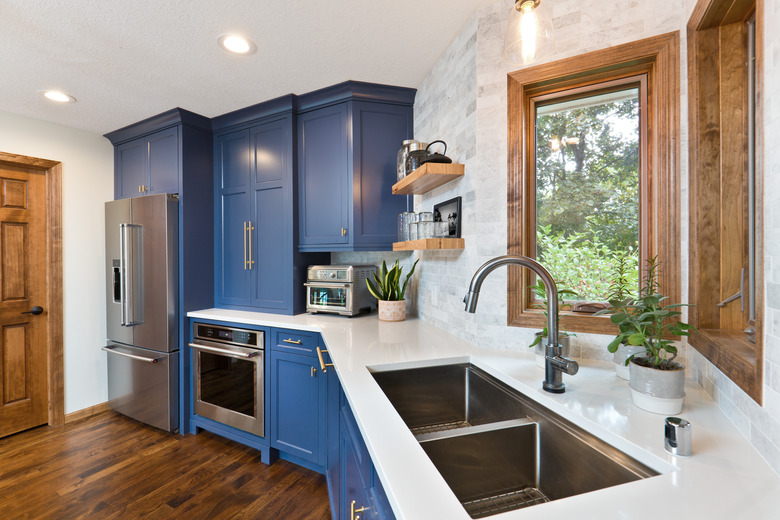How To Troubleshoot An InSinkErator Garbage Disposal
We may receive a commission on purchases made from links.
For an appliance that may seem simple, an InSinkErator garbage disposal, like all brands of disposals, can malfunction in a lot of different ways. Many of the things that might go wrong with your InSinkErator have simple DIY fixes, but you may not be able to safely resolve some problems without a plumber's help.
Troubleshooting a Clogged InSinkErator
Troubleshooting a Clogged InSinkErator
If water stays backed up in the sink when you run the garbage disposal, clogged food may be the culprit. When you drop food waste into your InSinkErator, it lands in a metal chamber comprised of a spinning impeller plate inside a stationary metal grinder ring. (All garbage disposals, regardless of brand and model, generally function in the same way.) Turning on the disposal makes the plate spin. Centrifugal force drives food waste over and over the grinder ring until it's broken down into fine particles that can slip through small holes in the chamber and be carried away with wastewater.
The grinder in your disposal is powerful, but it can't pulverize everything. Putting foods that don't belong in the disposal down an InSinkErator may cause a clog because they won't break down completely and will block the holes that carry water out of the disposal. Gummy foods, grease buildup, and other bits of trapped food debris can also cause clogs.
Plunging with a sink and drain plunger, which has a flat basin, can be an effective way to unclog an InSinkErator that's blocked by food waste. Fill the sink with enough water to cover the plunger's basin and then secure the plunger over the drain. Press down gently and up with a little force. If it's a double-basin sink, cover the nondisposal drain with a plastic or rubber drain stopper before plunging. If repeated plunging doesn't work, you may need to call a plumber, but first, investigate whether there's an object in the disposal that you can pull out.
Troubleshooting a Noisy InSinkErator
Troubleshooting a Noisy InSinkErator
Hearing a loud noise in your garbage disposal can mean a few things. If you hear banging or rattling when you turn on the InSinkErator, a foreign object, like a utensil or plastic bottle cap, may be trapped inside. Point a flashlight into the opening of your disposal to see if you can spot an obvious impediment. If so, unplug the disposal or turn off the circuit breaker that controls the device so it's not getting any electricity. Flip the disposal switch to make sure it's really off and then reach down into the disposal with a pair of tongs or pliers to grab the object.
Rattling can also indicate a problem with the impellers. They're dull metal "blades" connected to the spinning plate that help move food around the chamber while the disposal is turned on. Impellers are designed to spin around, but the bolts that hold them in place can become too loose over time, creating rattling sounds. Repairing loose impellers is something most people will want to leave to a professional.
Troubleshooting a Leaking InSinkErator
Troubleshooting a Leaking InSinkErator
If your garbage disposal leaks while it's running, the first step is pinpointing the source of the leak. Water could be seeping through the top of the InSinkErator where it meets the sink, out the bottom of the unit, or from the connections that attach the disposal to the dishwasher and your drain line.
A leak coming from the top of the garbage disposal indicates that the sink flange isn't holding its seal, which can often be fixed by scraping out and replacing the plumbers' putty inside the flange. This involves taking the garbage disposal out of the sink, so you may want to have a professional handle it. A leak coming from the bottom of the garbage disposal means the disposal needs to be replaced entirely. Water has gotten into parts of the unit that it shouldn't able to reach, and there's no easy fix for that.
A leak coming from one of the connections on the side of the garbage disposal may be fixed by simply tightening the screws on the clamp connecting the pipe to the disposal unit.
Troubleshooting a Jammed or Dead InSinkErator
Troubleshooting a Jammed or Dead InSinkErator
If you turn on the garbage disposal and nothing happens, the unit's overload protector may have been tripped. Press the red reset button on the bottom of the unit. This may solve the problem. If the button doesn't stay up, wait 10 minutes and try again.
If you turn on the disposal and hear a humming noise but the unit isn't spinning, the disposal is likely jammed. Fixing a jammed garbage disposal requires a garbage disposal wrench. One came with your original InSinkErator, but you can buy a replacement if it has gone missing. Fit one end of the wrench in the hole in the bottom of the disposal and crank it back and forth until you can turn the wrench in full circles. Make sure the red overload protector button is pressed in, turn on the water, and turn on the disposal.
